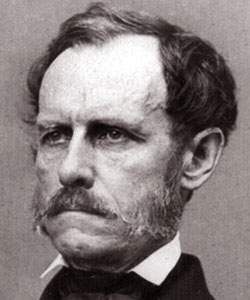John Adolphus Bernard Dahlgren (American National Biography)
Scholarship
Dahlgren was at the Washington Navy Yard in April 1861 at the outbreak of the Civil War. The yard's commander Franklin Buchanan resigned to "go South," and Dahlgren was appointed to replace him. On 16 July 1862 he was promoted to captain, and two days later he took command of the Bureau of Ordnance. Dahlgren's reputation and his proximity to the White House often brought him in contact with President Abraham Lincoln, outside of the normal chain of command, which was looked upon with some suspicion by Dahlgren's peers. On 7 February 1863 he was promoted to rear admiral. Four months later, 24 June, Dahlgren was ordered to take command of the South Atlantic Blockading Squadron.
As commander of the Blockading Squadron, Dahlgren's chief goal was the capture of the port of Charleston. His predecessor, S. Francis Du Pont, had tried and failed in this attempt and was recalled as a result. During Dahlgren's command Charleston was kept under siege for almost two years. Pressed at sea by Dahlgren's forces and from the land side by William Tecumseh Sherman's advancing army, the Confederates evacuated Charleston 17-18 February 1865. Dahlgren was ordered to transfer his command of the squadron 9 June, when the force was integrated with the Northern Blockading Squadron and returned to its prewar status as the Atlantic Squadron.
As commander of the Blockading Squadron, Dahlgren's chief goal was the capture of the port of Charleston. His predecessor, S. Francis Du Pont, had tried and failed in this attempt and was recalled as a result. During Dahlgren's command Charleston was kept under siege for almost two years. Pressed at sea by Dahlgren's forces and from the land side by William Tecumseh Sherman's advancing army, the Confederates evacuated Charleston 17-18 February 1865. Dahlgren was ordered to transfer his command of the squadron 9 June, when the force was integrated with the Northern Blockading Squadron and returned to its prewar status as the Atlantic Squadron.
William M. Fowler, "Dahlgren, John Adolphus Bernard," American National Biography Online, February 2000, http://www.anb.org/articles/04/04-00291.html.



